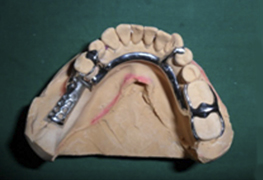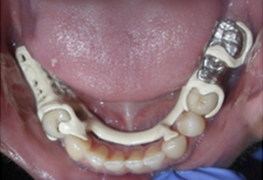A Denture is defined as a removable plate or frame holding one or more artificial teeth, which is used to replace missing teeth in the mouth. A Cast Partial Denture (CPD) is defined as a removable partial denture consisting of a cast metal framework that contains artificial teeth set in an acrylic resin.
As compared to conventional acrylic denture, Cast Partial Denture is stronger, more durable and retentive. However, the fabrication of cast partial denture is more costly, time-consuming and complex as compared to the conventional acrylic dentures. Each denture is specifically designed and fabricated to the individual patient.
Indications For A Cast Partial Denture
- • Partially edentulous (lose some of the teeth)
- • No tooth is present behind to edentulous space
- • Above the age of 17 years
- • Periodontal (gum) condition of the remaining teeth is good
- • Patient desires
- • Trauma to the jaw bone
- • When the remaining teeth have to be stabilized against lateral and anterior-posterior forces
Contraindication For A Cast Partial Denture
- • Poor oral hygiene
- • Aesthetically not pleasant area (especially front teeth area)
- • Weak teeth in the arch
- • Remaining teeth are not able to retain the removable prosthesis (dentures)
- • Rampant caries
- • Poor periodontal/gum health
Advantages Of A Cast Partial Denture
- • Minimises tissue change.
- • Reduces the necessity of relining or rebasing the denture.
- • Distribution of occlusal (biting stress) is good.
- • Movement of the denture bases has a massaging effect on the underlying bone and soft tissue.
- • Requires minimal direct retention as compared to the conventional acrylic denture.
- • Balance the occlusion (bite).
- • Provide support for lips and cheeks.
- • Eliminates the tipping strain on the teeth.
- • Prevent the teeth from shifting.
Disadvantages Of A Cast Partial Denture
- • Due to the incorporation of cast metal framework, cast partial denture becomes heavy and annoying to the patient.
- • Impossible to repair.
- • It is fragile.
- • Fabrication process is complex.
- • Takes more dental visits and longer time for the fabrication of cast partial denture.
- • Costly.
- • Lack of ability to prevent damaging lateral stresses.
- • It requires constant maintenance.
- • Aesthetically not pleasant.
Comparison Between Cast Partial Denture & Conventional Acrylic Denture
- 1. Cast partial denture is more hygienic and tolerable as compared to the acrylic denture.
- 2. Cast partial denture is more expensive to than the acrylic dentures.
- 3. Cast partial dentures have superior strength as compared to the acrylic dentures.
- 4. Acrylic dentures are easier to fabricate as compared to the cast partial denture.
- 5. Cast partial denture may damage the gum tissue around the natural teeth if it is not designed & cleaned properly.
- 6. Cast partial dentures are usually the better in the long run as compared to the acrylic denture.
Alternative Treatments To Cast Partial Denture
- • Dental Implant
- • Dental Bridge
- • Acrylic Denture
Each treatment option has its own indications and contraindications, thus, it is important to discuss with your dentist to figure out the best treatment option that is suitable for you.
Natural teeth always function better than the artificial teeth. Thus, it is very essential to prevent tooth loss in the first place through daily practise of good oral hygiene. Good oral health can be maintained through daily tooth brushing, flossing, use of mouthwash, tongue cleaning and regular dental visit. Always remember that good oral health care can result in good overall health.

